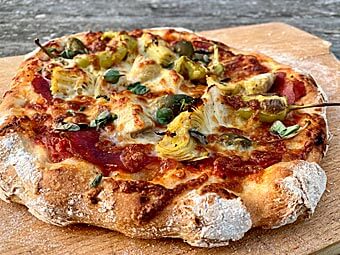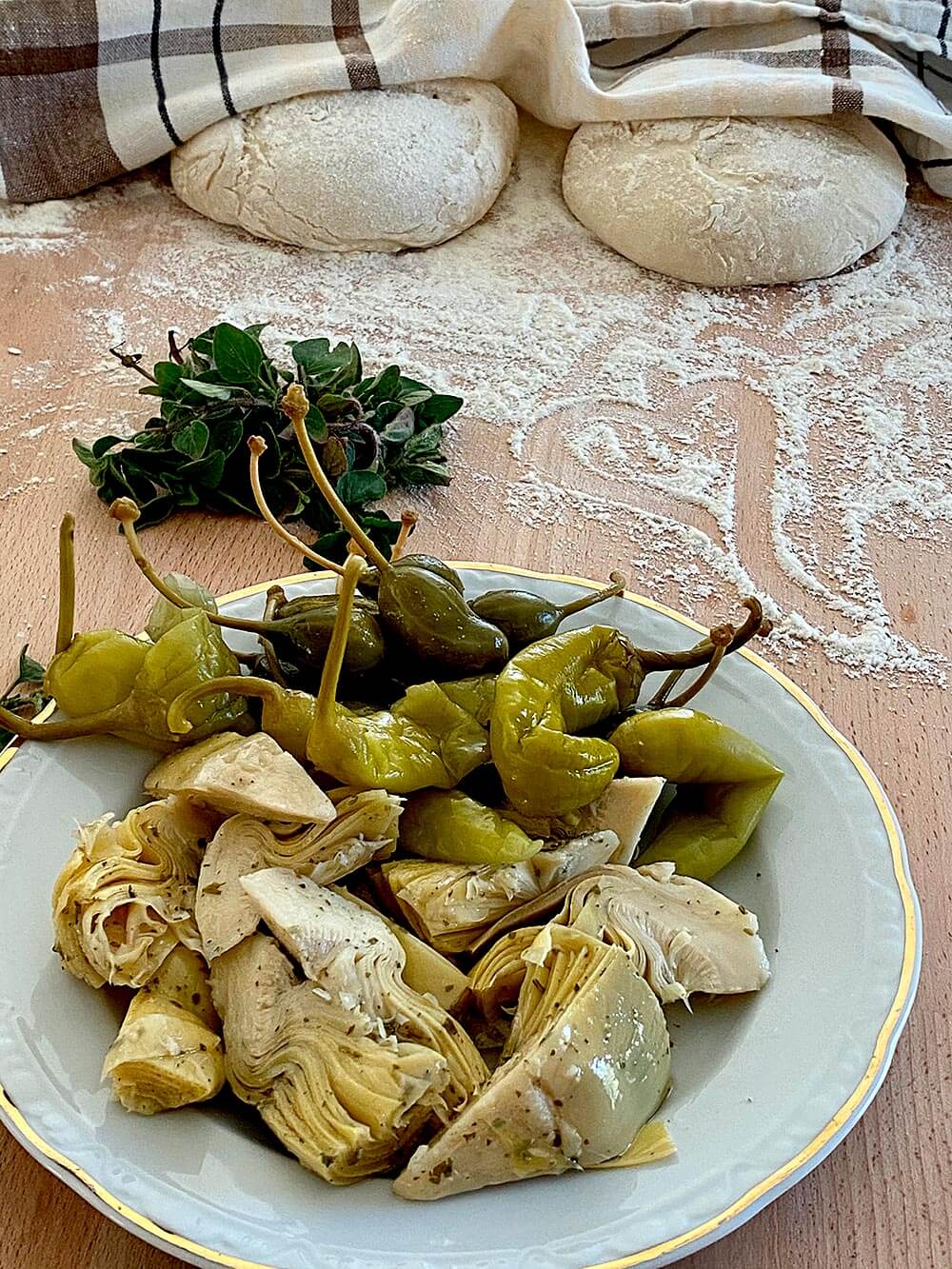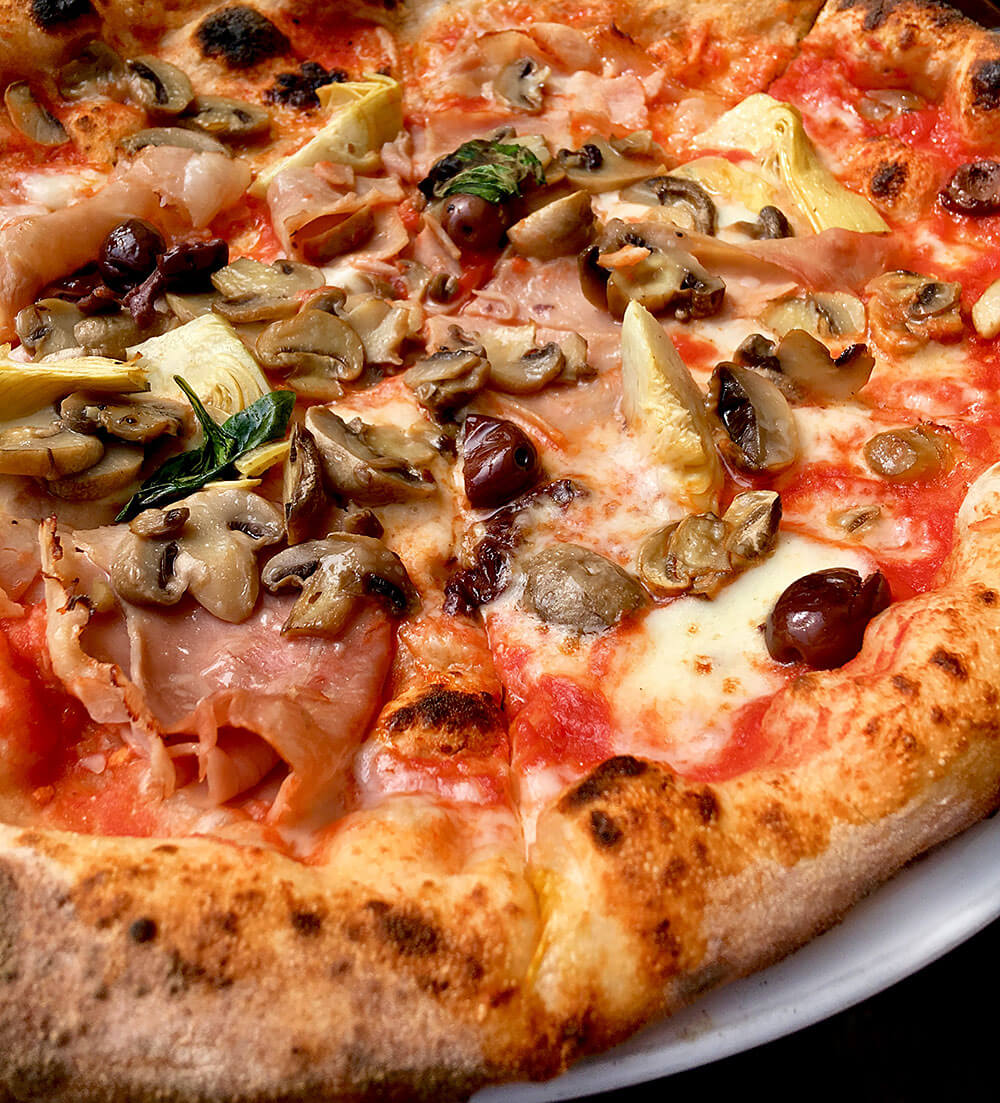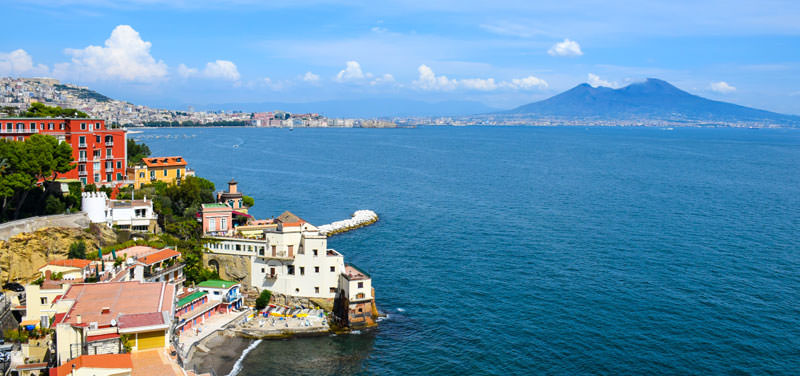
For a perfect pizza dough you actually only need 4 things. Namely: flour, water, yeast and salt. You should prepare the pizza dough for your pizza the day before and let it rise in the fridge for 24 hours, then it will be particularly fine and delicious.
By the way: If you don’t have your own outdoor pizza oven, like me, uses a Pizza stone. A great thing, the perfect pizza comes out almost like a real Italian restaurant.
Table of contents:
- Pizza dough basic recipe for the perfect pizza
- Make your own pizza dough with the food processor
- Make pizza yourself – pizza variations
- Best pizza in the world
- Best pizza in Naples
- Freeze fresh yeast
- The pizza and its history
- The perfect pizza in German
- Now it's your turn, your support is needed
Pizza dough basic recipe for the perfect pizza
I always use flour type 00. This type of flour is slightly finer than type 405 flour and gives the dough a softer consistency. Flour type 00 is available in Italian delicatessens or in a well-stocked supermarket. Today I recommend a pizza dough with 65% hydration.
Pizza dough ingredients for 6 pizzas:
- 1 kg flour, type 00
- 650 ml water, cold
- 2 g fresh yeast (or 0.7 g dry yeast). Yes, so little!
- 25 g fine sea salt
- some time and patience
Additionally required:
- 300 g Semola Rimacinata (durum wheat semolina)
- San Marzano tomatoes
- Pizza stone
- Pizza peel
- Pizza ball box
- Laser temperature gun (does not have to be unused)
- Cooling rack
- good olive oil
- Pizza cutter
- The ingredients for the topping, as desired
- Pizza dough time management
Example 24-hour stock cooking: If you want to make pizza on Saturday evening from 7 p.m., you should start making the pizza dough on Friday at 7:30 a.m.
Friday 7:30 a.m. / start making pizza dough
Friday 8:00 a.m. / Start Stockgare
Saturday 8:00 a.m. / end of stock cooking and start of air conditioning
Saturday 1:00 p.m. / end of air conditioning and start of piece cooking
Saturday 7:00 p.m. / End of piece cooking and start baking pizza
If you stick to these timings, you will have the basis for a perfect pizza. You can also leave the pizza dough in the oven for 48 or even 72 hours. The longer, the more aromatic the pizza dough will be. You can of course adapt the start of baking pizza to your needs. Of course you can also eat delicious pizza on Tuesday evening.
- Prepare the pizza dough (65% hydration = % water content per 1 kg of flour)
Pour 500 ml of cold water into a large bowl and dissolve the yeast in it. Now stir in approx. 200 g of flour and let it rest for 10 minutes.
Now gradually stir in the remaining 800 g flour until everything is well mixed.
Cover the pizza dough with a damp cloth and let it rest in the bowl for 10 minutes.
Now dissolve the fine sea salt in the remaining 150 ml of water and gradually stir it into the dough.
Take the dough out of the bowl and knead, fold, knead, fold, knead, fold… at least 10 minutes until it is nice and smooth. Tip: Rub your hands with a little olive oil beforehand, then everything will work better and won’t stick so much.
- Pizza dough stock cooking
Place the pizza dough on a clean surface and cover with a clean, damp cloth and let it rest for 1 hour. Now the yeast can work.
After the resting time, fold the pizza dough again and knead it.
Shape the pizza dough into a ball and place it in a bowl or food-safe plastic box that has been lightly rubbed with olive oil. Put the lid on or cover with cling film and place in the fridge for 24 hours.
- Preparation for piece cooking
Take the pizza dough out of the fridge after 24 hours and let it air condition at room temperature for 5 hours. Leave covered!
After the 5 hour resting time, remove the pizza dough from the bowl or plastic box and divide it into 6 equal pieces. Approx. 260 g to 280 g per pizza ball.
- Pizza dough piece cooking
Now form a pizza ball from each of the 6 pieces of pizza dough. Simply stick the dough into the bottom of the pizza ball again and again. Rub your hands with a little olive oil beforehand, then everything will go better and won’t stick so much. Practice makes perfect!
Now place the 6 pizza balls in a plastic box or a pizza ball box. Put the lid on and let it rest at room temperature for another 6 hours.
- Preheat the oven and pizza stone
Place the pizza stone on a baking tray and insert it in the upper third of the oven.
Set the top and bottom heat of the oven to a maximum of 275 degrees. A standard built-in oven heats between 250 and 275 degrees.
Preheat for at least 60-90 minutes. It’s best to always measure the temperature in the middle of the pizza stone with a laser temperature gun.
- Prepare pizza
Place a heap (approx. 300 g) of Semola Rimacinata on the work surface. Now remove a ball of pizza dough from the pizza ball box and place it on the pile and turn it once. Now carefully shape a mini pizza with your flat fingertips. Do not press the edge in.
Now place the pizza dough on a free surface and shape a round pizza with both flat hands. Do not press in the edge. Please DO NOT use a rolling pin!
Spread the tomato sauce. Not on the edge and not too much.
- Pre-bake and bake the pizza (my personal version)
Now pull the pizza onto a perforated pizza peel (removes the unnecessary semola at the bottom of the pizza). Pull the pizza into shape again.
Now the pizza can go into the oven. It stays here for about 4 minutes.
Take the pizza out of the oven with the pizza peel and place it on a cooling rack. Now let it rest for 30 seconds.
Now you can top the pizza however you like. For a real Pizza Margherita you still need Fior di Latte (translated as “flower of milk”), fresh basil and good olive oil.
Now the pizza goes into the oven. Before I put them in, I open the oven door and switch the stove to the top grill. Now wait about 10 seconds so that the oven loses some heat and the upper heating loop “starts up”. Now the pizza can go back into the oven. Close the door.
The pizza should remain under observation from now on. Depending on the degree of browning and your preference, take the pizza out of the oven, let it cool briefly and cut it into pieces with a pizza cutter. For the pizza at night, set the oven back to top and bottom heat. Let the oven heat up again. In the meantime, prepare the next pizza. and start again with step “A”.
Enjoy!
In short – after about 8 minutes of baking time, at around 275 degrees top and bottom heat and top grill, you have conjured up a perfect pizza on the table.
Preparation time: 30 hours
Quantity: 6 people
Cuisine: Italian



Make your own pizza dough with the food processor
I honestly can’t recommend it. If in a food processor then it must be a professional dough kneading machine, the one that kneads outside the center.
Make pizza yourself – pizza variations
Best pizza in the world
Here you will find restaurant tips to enjoy the best pizza in the world.
Italy
Chef: Franco Pepe
Website: pepeingrani.it
Address: Vico S.Giovanni Battista. 3, 81013 Caiazzo
Poland
Website: facebook.com/brusco.wroclaw
Address: Plac Teatralny 1, 50-051 Wrocław
USA
Chef: Chris Bianco
Website: pizzeriabianco.com
Address: 623 E Adams St, Phoenix, AZ 85004
Japan
Chef: Yoshihiro Imai
Website: restaurant-monk.com
Address: 147 Jodoji Shimominamidacho, Sakyo Ward, Kyoto, 606-8404
Best pizza in Naples
If you happen to be in Naples, the Pizzeria “Di Matteo” has them probably the best pizza. But bring time and nerves with you! Lots of people cavort in the already narrow Via dei Tribunali. A tussle and jostling, but that could also be the precursor to a small fight, which is going on in front of this pizzeria at noon. But the wait is worth it!
Freeze fresh yeast
A pack of fresh yeast, a cube, contains 42 grams. But since you only need 2 grams according to my recipe, you could bake a good 21 pizzas with it. So just freeze the leftover yeast. It is best to pack them in advance in 2 gram portions, put them in a small freezer box and then put them in the freezer. So you always have a supply at hand for bake your own bread.
The yeast can easily be stored for half a year in the freezer. To defrost, take the yeast out of the portioned packaging and place it in a small, deep plate in the overnight fridge. It may be that the yeast becomes slightly liquid. However, this has no influence on the quality.
On the subject of dry yeast: Basically, a pack of dry yeast with 7 grams corresponds to the raising power of half a cube of fresh yeast, i.e. 21 grams. For my recipe you would only need about 0.75 grams of dry yeast.
The pizza and its history
A pizza drizzled only with olive oil, topped with sliced tomatoes and basil or oregano, has been documented since the mid-18th century, when tomatoes became popular in southern Italy. Since pizza should be baked at a high temperature (450 degrees), which was only possible in a few households, the pizza was prepared and taken unbaked to the local baker until a separate branch of the pizza maker, the pizzaiolo, emerged, who then made the pizza dough self-made and of course also covered.

A pizza is said to have been made for the first time on June 11, 1889 in Naples by Raffaele Esposito of Pizzeria Brandi, who is said to have been commissioned to serve a pizza to King Umberto I and his wife Margherita. He is said to have patriotically decorated them with ingredients in the Italian national colors: basil, mozzarella and tomatoes. However, this story has been refuted by historians.
Queen Margherita had pizza brought to the palace by other pizzaiolos beforehand. In 1880 a newspaper article about this also appeared in the Washington Post; From a list of 35 different pizza toppings, she chose eight varieties, which were then baked especially for her. But this pizza baker was not Raffaele Esposito. He was merely the only one who kept the court’s receipt.
The perfect pizza in German
You can find this article in German at www.rolfkocht.de as “Die perfekte Pizza: Luftig, locker und leicht – Pizzateig Grundrezept, wie beim Italiener”
Now it's your turn, your support is needed.
Did you like the post "The perfect pizza: airy, fluffy and light – basic pizza dough recipe, just like in Italy"?
Simply select the number of stars and click. Thank you very much for your review ![]()







